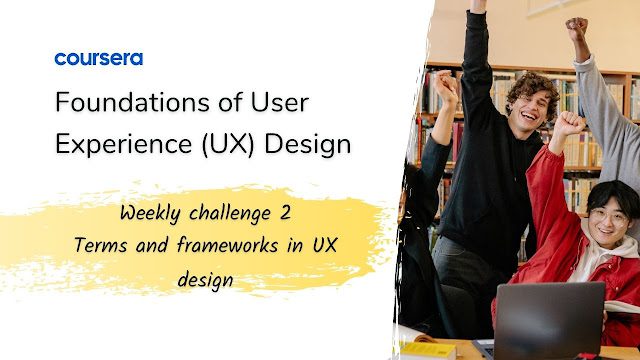Weekly challenge 2 Terms and frameworks in UX design Quiz Answer
Hello Friends in this article i am gone to share Weekly challenge 2 Terms and frameworks in UX design Quiz Answer with you..
Enroll Link: Foundations of User Experience (UX) Design
Also visit this link: Weekly challenge 1 The Basics of User Experience Design Quiz Answer
Weekly challenge 2 Terms and frameworks in UX design Quiz Answer
Question 1) As a UX designer, your goal is to focus on the end user.
- True
- False
Question 2) A designer completes the first three steps of the user-centered design process. This results in a design they hope will solve the end user’s problem. What is the final step in the process?
- Ideate
- Iterate
- Evaluate
- Prototype
Question 3) In which step do designers come up with ideas for what the product might look like?
- Understand
- Evaluate
- Design
- Specify
Question 4) Fill in the blank: In UX design, frameworks represent the _____.
- user-tested prototype
- end user for a product
- optimal design solution
- outline of a project
Question 5) Which of the elements below is the bottommost layer of the five elements of UX design?
- Strategy
- Structure
- Skeleton
- Surface
- Scope
Question 6) What types of platforms does a designer need to keep in mind when designing a product? Select all that apply.
- Books
- Mobile apps
- Desktop
- Television (TV)
Question 7) What can a designer do to create a consistent brand identity across platforms? Select all that apply.
- Design a custom app, to direct all users to a single platform experience
- Create unique color schemes for each platform.
- Establish a consistent company voice across platforms
- Create a consistent visual appearance across platforms
Question 8) What should you consider when creating an equity-focused product?
- Accommodating the needs of users who have been historically excluded from the design process.
- Accommodating the needs of all possible users, using a one-size-fits-all design approach.
- Accommodating the needs of users who are in the primary market segment for a product.
- Accommodating the needs of users with the widest range of abilities, in the widest range of situations.
Question 9) Which of the following user experience design frameworks include strategy as a step?
- Design thinking
- User-centered design
- Five elements of UX design
Question 10) Why should UX designers focus on the next billion users (NBU) in the design process?
- To design for historically underrepresented user groups, and increase accessibility
- To design for future internet users, who are just getting online
- To design for a desktop-first audience, and adapt experiences to larger screens
- To design for current internet users, and create experiences to meet their needs
Question 11) Identify examples of assistive technology. Select all that apply.
- Screen reader
- Pencil
- Alternative text
- Color modification
Extra Question
Question 12) An end user is the specific audience a UX designer creates something for.
- True
- False
Question 13) Which of these are steps in the user-centered design process? Select all that apply.
- Design
- Specify
- Delete
- Understand
Question 14) User-centered design begins with the step: understand. What is the second step of the process?
- Specify
- Iterate
- Design
- Evaluate
Question 15) Identify key frameworks in UX design. Select all that apply.
- User-centered design
- Design thinking
- Five elements of UX design
- Draft design
- Build products that meet the needs of specific individuals and groups who have been excluded in the past.
- Build products for users with the widest range of abilities and in the widest range of situations
- Build products for one type of user, so the benefits can extend to many other types of users.
- User-centered design
- Five elements of UX design
- Design thinking
- Users who are about to become internet users
- Users who are transitioning from desktop to mobile
- Users who are in the field of technology
- Users who are adapting to cloud-based technology
- True
- False
- Collects and synthesizes research on your end user’s wants, needs, and pain points
- Applies the design principles and best practices that can best support your end user
- Shares your proposed design solutions with stakeholders and developers
- Creates the basic structure that focuses and supports the problem you want to solve
- Structure
- Scope
- Skeleton
- Surface
- Strategy
- How products will work cross-platform
- How to optimize design for the designer’s preferred platform
- Which platforms control the largest market share
- When backward-compatibility should be prioritized over optimal design
- identical
- similar
- different
- Design thinking
- User-centered design
- Five elements of UX design
- the data you have collected about similar users
- the interactive elements you have included in your prototype
- the insights you have gathered about users
- the feedback you have incorporated in design updates
- Skeleton
- Scope
- Strategy
- Surface
- Structure
- User experience should be consistent from platform to platform.
- Design frameworks must be tailored for each platform.
- Brand identity may change platform to platform.
- Functionalities vary platform to platform.
- Maybe. User experience design should maximize accessibility, which focuses on current users who have been historically underrepresented in design.
- No. User experience design should focus on one user group at a time. The first priority should be designing for current users, and later, future internet users.
- Yes. User experience design should focus on existing users as well as the “next billion users,” who are just now getting online.

